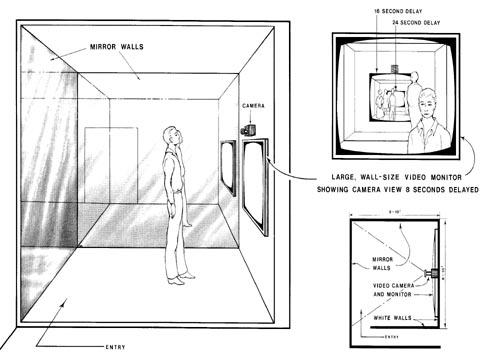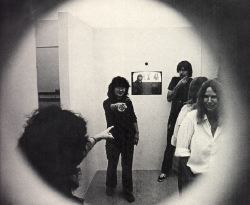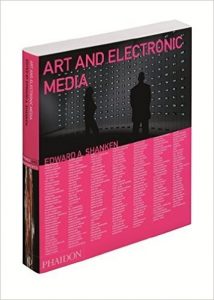Present Continuous Past(s) is a piece where present time is reflected. This piece was created by a diverse artist named Dan Graham. 1 “Graham was owner of a gallery, art and culture theorist, photographer, film producer, performance and installation artist. A pioneer in performance and video art in the 1970’s, Graham later turned his attention to architectural projects designed for social interaction in public spaces.” The whole process sounds a little confusing when reading it for the first time, but after reading it a few times and understanding the meaning behind the piece, it becomes a little easier to comprehend the process of the work.

1″The mirrors reflect present time. The video camera tapes what is immediately in front of it and the entire reflection on the opposite mirrored wall. The image seen by the camera (reflecting everything in the room) appears eight seconds later in the video monitor (via a tape delay placed between the video recorder, which is recording, and a second video recorder, which is playing the recording back).
If a viewer’s body does not directly obscure the lens’s view of the facing mirror the camera is taping the reflection of the room and the reflected image of the monitor (which shows the time recorded eight seconds previously reflected from the mirror). A person viewing the monitor sees both the image of himself or herself of eight seconds earlier, and what was reflected on the mirror from the monitor eight seconds prior to that–sixteen seconds in the past (the camera view of eight seconds prior was playing back on the monitor eight seconds earlier, and this was reflected on the mirror along with the then present reflection to the viewer). An infinite regress of time continuums within time continuums (always separated by eight-second intervals) within time continuums is created.
The mirror at right angles to the other mirror-wall and to the monitor-wall gives a present-time view of the installation as if observed from an «objective» vantage exterior to the viewer’s subjective experience and to the mechanism that produces the piece’s perceptual effect. It simply reflects (statically) present time.”

The concept of the piece is to bring self-awareness to the viewer of how people perceive them by lagging the time of the present by 8 seconds and allowing them to view the video of themselves. 2 “This impression is something we rarely see and it makes the viewer self-conscious because he now knows how others perceive him (only in the physical sense).” According to Graham, it also allows you to experience a different way of seeing yourself and learning something new about yourself.
It’s definitely a great way for the viewer to participate and interact with the art, which allows for them to step away from the piece with a different outlook on art and themselves.
1 Media Art Net: http://www.medienkunstnetz.de/artist/d.graham/biography/ Accessed December 2, 2012
2 Party Hard with Sova: http://partyhardwithsova.wordpress.com/2011/08/17/dan-graham-present-continuous-pasts/ Accessed December 2, 2012
